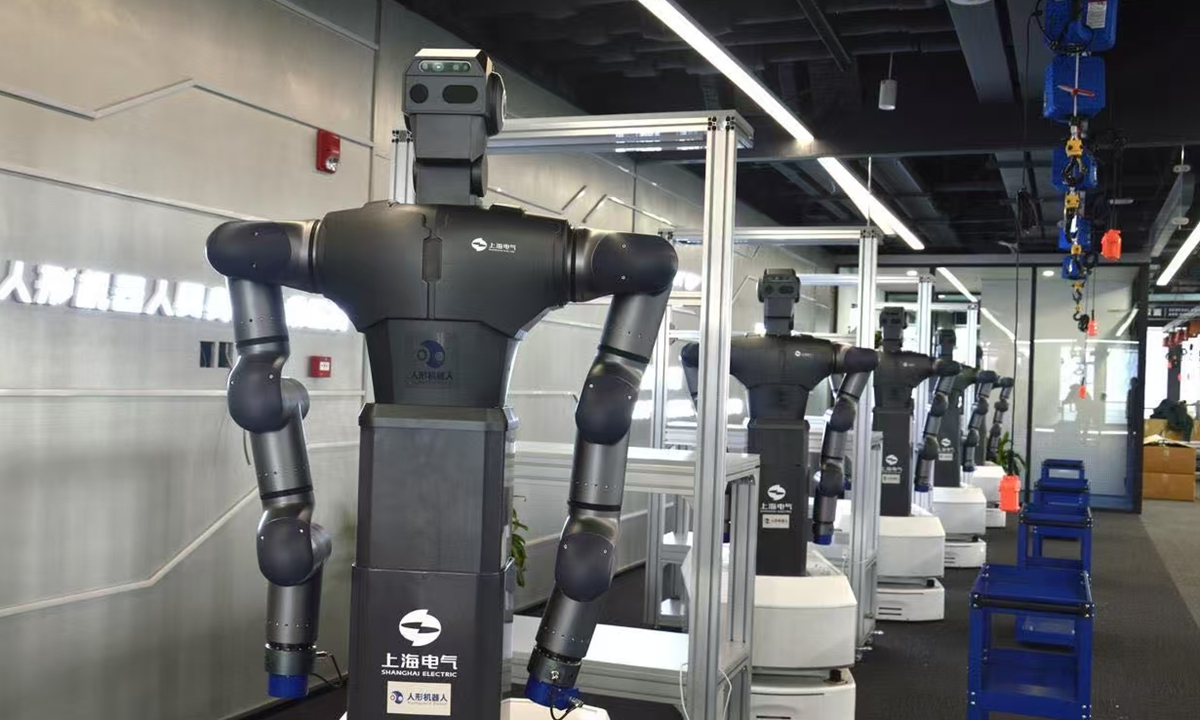
China is preparing to launch its first large-scale training facility for heterogeneous humanoid robots (异构人形机器人) in Shanghai’s Zhangjiang area this July. Operated by the National and Local Co-built Humanoid Robotics Innovation Center, the 5,000-square-meter center will train over 100 types of robots from more than a dozen companies, making it the country’s most diverse hub for advancing robotic applications in daily life and workplaces.
The facility aims to address key challenges in the humanoid robotics industry by enabling large-scale data sharing, developing shared technologies, and building ecosystems. By simulating real-world scenarios—such as homes, factories, hospitals, and farms—the center collects data generated during robot training to create a database for improving future models.
Heterogeneous humanoid robots, which vary in structure and function, are central to the project. Differences in joint numbers, motor power, or design across manufacturers create unique datasets that often limit compatibility (兼容性). The center’s mission is to unify these datasets, allowing robots to learn from shared experiences. During the initial training phases, robots practice “atomic skills” like grasping, picking, and transporting objects. These basic actions form a skill library for complex tasks, such as folding clothes, organizing shelves, or cleaning risky equipment.
According to a data collector, generating data, collecting data, augmenting (增加) data, and analyzing data are the most fundamental core tasks at the training center. “Even simple actions like ‘grasping’ require extensive repetition,” explained a data collector. A single motion might be repeated 600 times daily to account for variables like object size or angle.
The center currently produces 20,000–30,000 data entries daily during testing, with plans to reach 50,000 entries per day after its July launch. By year-end, it aims to collect over 10 million real-world data entries. A key long-term plan involves creating a data exchange platform where companies can share scenario-specific data (e.g., healthcare or household tasks) to avoid redundant efforts. The center also seeks to develop a universal “super brain” AI model, enabling diverse robots to collaborate efficiently.
原创编写 版权所有 侵权必究! 每日更新 个性化阅读 英语飙升!
1.1. What is the primary purpose of China’s new humanoid robot training facility?
A To compete with international robotics manufacturers.
B To establish universal standards for robot appearance.
C To overcome industry challenges through shared resources.
D To develop entertainment robots for household use.
解析:选C。细节理解题。根据第二段的“The facility aims to address key challenges in the humanoid robotics industry by enabling large - scale data sharing, developing shared technologies, and building ecosystems.”可知,该设施旨在通过实现大规模数据共享、开发共享技术以及构建生态系统,来应对人形机器人行业的关键挑战。故选C。
2.2. What issue limits compatibility among heterogeneous humanoid robots?
A Insufficient funding for research and development.
B Lack of government regulations in robotics.
C Limited training facilities for basic robot skills.
D Unique datasets caused by structural and functional differences.
解析:选D。细节理解题。根据第三段的“Differences in joint numbers, motor power, or design across manufacturers create unique datasets that often limit compatibility.”可知,不同制造商在关节数量、电机功率或设计上的差异,产生了独特的数据集,而这些数据集常常限制了兼容性。故选D。
3.3. Why do robots repeat basic motions hundreds of times during training?
A To memorize fixed movement patterns.
B To account for environmental variables.
C To test different material durability.
D To reduce computational errors.
解析:选B。细节理解题。根据第四段中的“A single motion might be repeated 600 times daily to account for variables like object size or angle.”可知,一个单一动作每天可能要重复600次,是为了考虑物体大小或角度等变量。所以选B。
4.4. What can be inferred about the future “data exchange platform”?
A It will focus only on industrial scenarios.
B It will replace human trainers in robot development.
C It requires robots to have identical designs.
D It aims to reduce repetitive data collection efforts.
解析:选D。细节理解题。文章最后一段提到“A key long - term plan involves creating a data exchange platform where companies can share scenario - specific data (e.g., healthcare or household tasks) to avoid redundant efforts.”可知,一项关键的长期计划包括创建一个数据交换平台,企业可以在该平台上共享特定场景的数据(例如医疗保健或家务任务相关的数据),以避免重复劳动。所以选D。